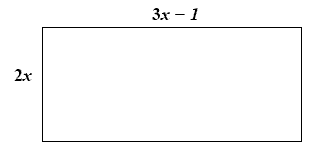Print this page
view more examples
Topic: Algebraic Manipulation and Formulae (Higher - Unit 3)
| Specification References: N5.1h N5.1h Manipulate algebraic expressions by collecting like terms, by multiplying a single term over a bracket, and by taking out common factors. Multiply two linear expressions. |
Candidates should be able to:
- understand that the transformation of algebraic expressions obeys and generalises the rules of generalised arithmetic
- manipulate an expression by collecting like terms
- multiply a single term over a bracket, e.g. a(b + c) = ab + ac
- write expressions to solve problems
- write expressions using squares and cubes
- factorise algebraic expressions by taking out common factors
- know the meaning of 'simplify', e.g. Simplify 3x - 2 + 4(x + 5)
- know the meaning of and be able to factorise, e.g.
Factorise 3x2y - 9y
Factorise 4x2 + 6xy - expand the product of two linear expressions, e.g. (2x + 3)(3x – 4)
Examples
- This rectangle has dimensions as shown.
Write down an expression in terms of x for- the perimeter
- the area

The perimeter of the rectangle is 68 centimetres.
Use this information to form and solve an equation to work out the dimensions
of the rectangle.
view more examples
